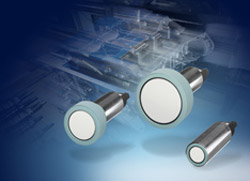Reduced blind zone and shorter design of sensors advantageous for close-up range

The new sensors of the compact series in M30 design have a reduced blind zone and are shorter than models of the previous generation. These improvements make for better detection of objects at close range and reduce the space requirements of the components. The new programming interface lets users read out status and diagnostic information in running operation without any reaction. This means you can easily adapt the parameters to the operating environment for process optimization.
The space requirement of a sonar proximity switch in a machine or plant is mainly determined by its blind zone. The switch must be installed at a location that is set back by the length of the blind zone from the detection range to ensure reliable detection of the close-up range. This so-called dead space is reduced by more than 50 percent for the latest generation of Simatic PXS sonar proximity switches – space available to reduce the size of the machine or plant. The extremely narrow sonic lobe and the improved noise suppression make for object detection even under difficult environmental conditions and will thus increase machine availability.
The reactionless transmission of sensor data in measurement operation makes for exact setting of parameters to the application. The result is an increased quality of the sensor signal. The sensors in M30 design are available for four different detection ranges up to six meters. The K1 version has one switching output; the K2 version has two. K3 is available in several versions: with one switching and one analog output, with one IO-Link channel or Atex certification for operation in Ex-Zone 2/22. Versions with rotary head or recessed converter are available for K2 and K3 sensors.
Parameter setting of the sonar proximity switches takes place either through simple setting of the potentiometer on the device itself or more conveniently with the parameter-setting tool: it provides reactionless access to detailed realtime sensor data without interruption of the measuring operation. You can, for example, visualize several echos at different intervals and quality to optimize the parameters for the application. The tool is connected via infrared adapter so that you do not interrupt existing measurement connections.
The new Simatic-PXS sonic proximity switches can detect all objects that reflect ultrasonic waves. Their application ranges from measurement of filling and stacking levels, height detection all the way to distance measurements. The sensors detect objects with widely differing characteristics, regardless of whether they are liquid, solid, powder or even transparent and if their surfaces are rough or smooth, clean or dirty, wet or dry. They are not sensitive to extraneous influences such as light or temperature and they are extremely dependable under changing or difficult environmental conditions. The sensors emit ultrasonic waves. If these are reflected off objects, the resulting echo is converted into an electrical signal and the time between the transmitted pulse and echo pulse is measured to determine the distance.
Media Contact
More Information:
http://www.siemens.com/simatic-sensors/pxAll latest news from the category: Machine Engineering
Machine engineering is one of Germany’s key industries. The importance of this segment has led to the creation of new university degree programs in fields such as production and logistics, process engineering, vehicle/automotive engineering, production engineering and aerospace engineering among others.
innovations-report offers informative reports and articles covering technologies such as automation, motion, power train, energy, conveyor, plastics, lightweight construction, logistics/warehousing, measurement systems, machine tools and control engineering.
Newest articles

High-energy-density aqueous battery based on halogen multi-electron transfer
Traditional non-aqueous lithium-ion batteries have a high energy density, but their safety is compromised due to the flammable organic electrolytes they utilize. Aqueous batteries use water as the solvent for…

First-ever combined heart pump and pig kidney transplant
…gives new hope to patient with terminal illness. Surgeons at NYU Langone Health performed the first-ever combined mechanical heart pump and gene-edited pig kidney transplant surgery in a 54-year-old woman…

Biophysics: Testing how well biomarkers work
LMU researchers have developed a method to determine how reliably target proteins can be labeled using super-resolution fluorescence microscopy. Modern microscopy techniques make it possible to examine the inner workings…





















